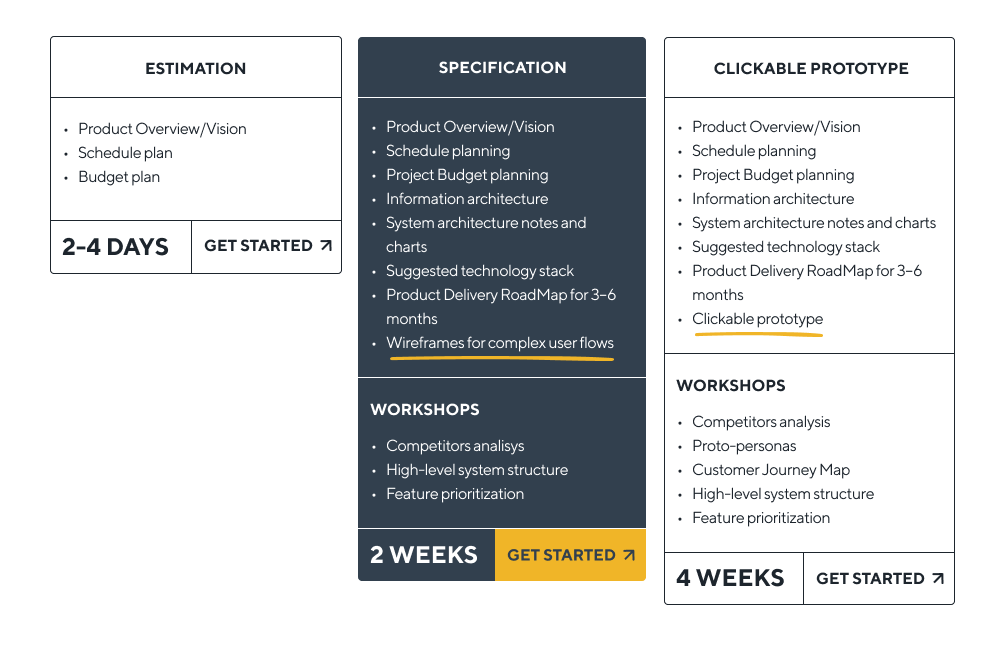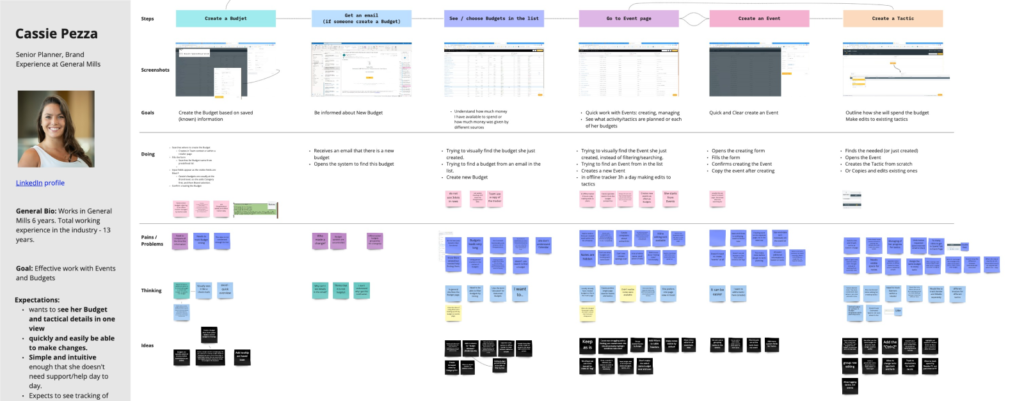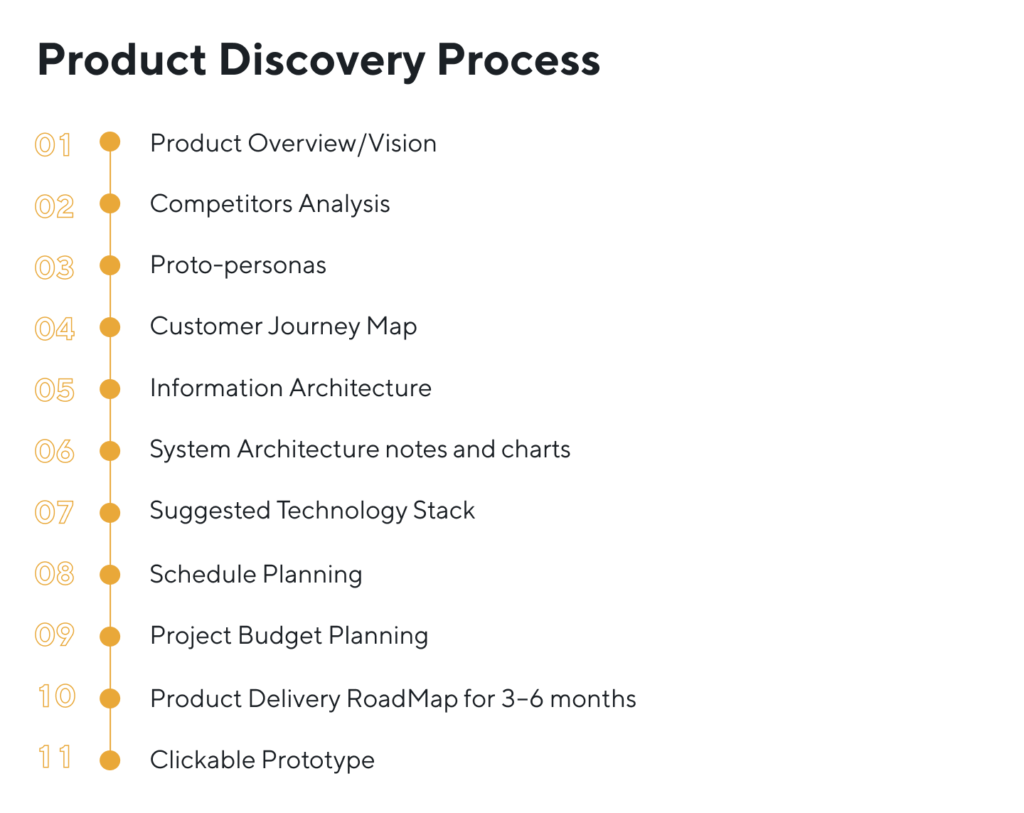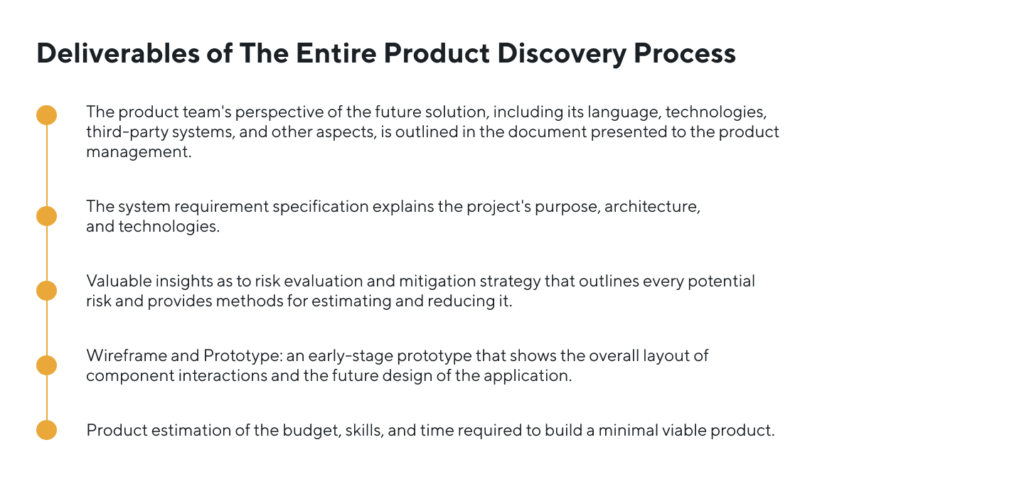Many startup founders often discover they have made false assumptions about the users’ real needs after the software product’s release. And that’s a disaster. You have invested your money in a product that doesn’t meet the user’s expectations. So it can never be successful on the market.
The LaSoft team’s advice is not to neglect the product discovery stage, as it is vital in software development and greatly increases the product’s chances of success. The product discovery stage goals are the following:
- To understand what problem the client wants to solve;
- To understand the end-user profile;
- Discover solutions that are already available on the market. Make sure that the problem is actual;
- Consider the client’s limitations and design a possible solution for the problem.
- Scope, estimate, and plan the delivery;
- Provide the client with an adequate and accurate estimate for the realization of the project.
Introduction to Product Discovery
So you have an idea for a product. That’s where product discovery comes in. It’s a process of researching, testing and validating your idea before fully committing to it. This is crucial for ensuring that your product meets the needs and wants of your target audience and that it will be successful in the market. Think of it like a road map for your software development process. By doing your due diligence in product discovery, you’ll have a better chance of creating something people will want to use and, ultimately, will be able to generate revenue for your business.
Product discovery is the foundation of any successful design process. It’s the stage where the Business Analyst, System Architect, Product Designer, and Stakeholders work together to identify and define the problem they’re trying to solve and the value they’re trying to create.
What Are The Steps of The Product Discovery Process in LaSoft?
Usually, there are three offers for the Product Discovery stage in LaSoft, and our experts take 40 to 60 hours to cover them.
Our second offer, “Specification,” helps you get that with provided artifacts, including wireframes. You should be able to double-check (validate) if your idea makes sense to potential users. A wireframe helps you visualize your idea and communicate it much easier.

The main advantage of our third offer is getting the clickable prototype to start real-time user testing and gaining insights and ideas about whether your product will succeed commercially. We encourage you to check LaSoft’s offers. for startups and SMBs to create fast and secure MVP (minimum viable product) with professional tools and up-to-date technologies.
Understanding the Product Discovery Team
The software product discovery team is a blend of diverse skills and roles, each contributing uniquely to the product discovery process. Each member, from product managers and business analysts to product designers, is vital in shaping the digital product.

| Business Analysts | Business Analysts assess business objectives and possible technological solutions. They are instrumental in defining the business needs and translating them into actionable development tasks. |
| System Architect | The System Architect is responsible for setting the product vision, aligning team efforts with market needs, ensuring the end product resonates with users. |
| Product Designers | Product Designers bring the product to life by designing user-centric and aesthetically pleasing interfaces. Their work is crucial in ensuring the product is functional, engaging, and easy to use. |
The Role of Market Research in Product Discovery
Have you ever wondered how your favorite products and services came to be? It all starts with market research. Companies need to identify their user needs and pain points to create a product that meets and solves those needs. Companies can learn about their customers’ preferences, behaviors, and pain points by conducting thorough research. This information helps the Discovery team align with their target audience. It’s also vital to analyze competitors to know the niche for your product on the market.
Competitor Analysis Real-Life Example From LaSoft
You must clearly understand the market you want to enter and research your rivals’ success or failure cases. Since those competitors are in the same market as you, they will compete directly with your product in the future. We want to share an example of our discovery team competitors’ analysis.
Real-Case Example P4BeSpoke App Project
We made a discovery for the P4BeSpoke app project. The idea was to develop an app where the users could get online coaching. Our team delved into the fitness app development niche during the discovery stage. Our research showed an increasing need for fitness and health app development. We found that users’ demand for the SporTech app is vital. Adopting a user-centric design methodology is essential to guarantee that all features and interface components are created with the requirements and preferences of the user in mind. We developed a plan, user flows, user stories, and a project roadmap to create a workable and efficient digital solution.
Goals Set Before the Discovery by the LaSoft Team
- Discover the product’s idea
- Complete Competitors’ Discovery
- Specify User Personas
- Prepare Problem definitions
- Specify the Features
- Create Features vs Users matrix
Competitors Discovery Example
| Resource | Traffic (monthly) | Main Features, Advantages, Disadvantages, | Audience focus | Pricing |
| Peloton | Average monthly traffic - 710K Device distribution: Desktop - 50.04% Mobile app - 45.96% | Peloton is a global interactive fitness platform that brings the energy and benefits of studio-style workouts to the convenience and comfort of home. With thousands of classes across various disciplines taught by a roster of elite instructors, Peloton delivers real-time motivation and curates playlists from the world’s best artists. In the UK, the brand’s immersive content is accessible through the Peloton Bike and the Peloton app, which provide a full state of fitness offerings. Pros: Plenty of exercise modes Different categories available Interactive workouts Workout programs Social Media features Cons: Is not very customizable Inconvenient UX Limited app localization | Geography: US - 89.52% Canada - 2.29% UK - 1.74% Germany - 0.81% Australia - 0.42% Gender distribution: Male - 40.6% Female - 59.4% Age Distribution: 18-24 - 7.24% 25-34 - 31.66% 35-44 - 21% 45-54 - 19.56% 55-64 - 14.04% 65+ - 6.5% Geography: US - 27.94% UK - 15.57% Canada - 13.39% Kyrgyzstan - 7.28% France - 6.05% Gender distributions: Male - 28.88% Female - 71.12% Age Distribution: 18-24 - 8.55% 25-34 - 36.49% 35-44 - 17.91% 45-54 - 18.97% 55-64 - 12.05% 65+ - 6.03% | Pricing info: Free Students - $6.99/mo Military - $9.99/mo Doctors - $9.99/mo Veterinarians - $9.99/mo Educators - $9.99/mo First Responders - $9.99/mo |
| Alo Moves | Average monthly traffic - 710K Device distribution: Desktop - 50.04% Mobile app - 45.96% | Alo Moves is a video-based fitness training from the world’s top coaches. Main features: Yoga and Mindfulness classes Community features Pros: Wide variety of workouts Wide variety of Coaches Sportswear online shop Weekly workouts update High-quality video Cons: Unclear pricing model Poor diversity (ages, sizes) Poor customer support No free content Filtering might be glitchy | Geography: US - 27.94% UK - 15.57% Canada - 13.39% Kyrgyzstan - 7.28% France - 6.05% Gender distributions: Male - 28.88% Female - 71.12% Age Distribution: 18-24 - 8.55% 25-34 - 36.49% 35-44 - 17.91% 45-54 - 18.97% 55-64 - 12.05% 65+ - 6.03% | Membership pricing: $19.99/mo $199.99/mo |
| Future | Average monthly traffic - 115.9K Device distribution: Desktop - 30.96% Mobile web - 69.04% | Pros: Easy to use Has an integration with wearable devices Tailored product Personalized onboarding Personalized Coach’s search Cons: Limited exercise selection Is not aimed for people with injuries Poor Coach support Limited localization | Geography: US - 57.36% Norway - 11.17% Saudi Arabia - 4.16% Sri Lanka - 4.08% UK - 3.62% Gender distribution: Male - 50.25% Female - 49.75% Age Distribution: 18-24 - 11.38% 25-34 - 35.05% 35-44 - 18.35% 45-54 - 17.93% 55-64 - 11.63% 65+ - 5.74% | Pricing info: Annual - $149/mo 6 Month - $169/mo 3 Month - $179/mo Monthly - $199/mo |
Insights:
- Peleton mainly focuses on the USA market in their marketing effort, which means we can compete in other markets, like the UK, for example, with our client.
- Alo Moves is a more expensive tool targeting mainly the female part.
- Future is the most expensive option and offers integration with wearables, but it is new to the market as they have the lowest monthly visits on their page.
Those and many other insights about your competition will help you position your product on the market and find your niche.
Understanding User Personas/Proto Personas
Creating user personas is an important component to understanding your target audience. It’s important to remember that your customers aren’t just numbers or data points. They’re real people with unique needs, preferences, and pain points. By identifying user personas and creating user scenarios, you’ll better understand your customers and what they want in a software product. So, when you develop user stories, user flow, and user journeys, you get valuable insight that can help you tailor your marketing and product core functionality efforts to meet users’ needs better, resulting in greater customer satisfaction and, ultimately, a more successful business.
| Proto Persona Example |
| Amanda Danes Age: 32 y.o. Work: Layer Education: Master’s degree in Legal Location: Chicago, USA Character: Amanda is an attentive and responsible person. That is why she spends a lot of time at work; she works overtime to complete planned tasks. Pain point: Amanda has a pretty busy working schedule and is facing a problem in that she cannot find a Coach who will be able to train her because of her lack of time Goal: Amanda is looking for a solution where she can easily schedule a workout and have constant access to her Coach. |
Proto Persona Example + User Journey Map

Identify Typical Issues
You’ve collected and spent hours analyzing all the data, and now you’re left with a mountain of information. This is where a well-crafted problem statement comes in handy. Create a concise and specific problem statement using the data you’ve gathered. You can communicate the issue and pave the way for a targeted solution. Think of it as the roadmap to your data-driven decision-making process for the future development of essential functionality. The project team defines the project’s scope. It establishes the best product architecture to cover all possible needs of the potential users and, as a result, to meet demand in the market.
Project Estimation
Project estimation is a critical aspect of project management that involves breaking down the project into modules and individual tasks In LaSoft, we use at least 3 different techniques for effort estimation, but all require at least some upfront preparation.
| Estimation Approach | Time Effort to Estimate Average project | Project Discovery Stage | Possible Deviation |
| Estimation by project analogy | 2 hours | Product vision | -50% / +100% |
| Estimation of high-level project structure | 5 hours | High-level structure | -45% / +75% |
| Estimation using the amount of User Stories | 40 hours | Specification | -25% / +35% |
| Estimation using a number of Application Pages | 200 of design + 5 hours | UI/UX | -20% / +25% |
| A) Verification by expert judgment | 50 hours | Architecture | -20% / +25% |
| B) Verification with calendar schedule | 50 hours | Planning | -15% / +20% |
As you can see, the more time you spend on the project discovery, the better and more accurate estimation you get as a result.
| Step 1. Compound List of Tasks and Resources | The initial step in project estimation involves creating a comprehensive list of tasks and identifying the necessary resources to complete them. This stage simplifies the project by breaking it down into manageable stages, allowing for a more accurate assessment of time and cost when assigning tasks to a dedicated team. Example tasks may be research and planning, design, front-end/back-end development, copywriting, testing, and launching to the market. Keep in mind that each project has a unique task list, but the objective remains the same: ensuring efficiency. |
| Step 2. Designing The Optimal Solution | Effective project estimation takes into account the size of the team the project needs. Capacity planning ensures that projects proceed smoothly and remain on schedule. |
| Step 3. Creating a High-Level Architecture of the Solution | Accurate project cost estimation demands a realistic approach. It's imperative not only for the project's success but also for the team's effective workflow. |
| Step 4. Estimation of the Separate Parts of the Solution | Accurate cost estimation ensures that your project remains financially viable. Estimating project costs requires thoroughly assessing scope, schedule, and resources. It's essential to understand the financial aspects before diving into a project. |
Identify Tools for Research and Prototyping
These handy tools can help you identify gaps in the market, analyze consumer trends, and ultimately create products that cater to your customers’ needs. With the right tools at your disposal, you can ensure that your products will be a success. Tools like Miro and Figma are popular choices to help you visualize ideas and improve the user experience. With Miro and Figma, you can create user persona boards, customer journey maps, and other visual aids to help better understand your potential clients. The LaSoft team also chose Figma to create clickable prototypes and test them with actual users to gather feedback.
Prototyping and Usability Testing
Prototyping is a tool to create visual representations of product ideas. Some customers order it to create a preliminary product version, which is tested, evaluated, and improved upon until a final version is developed. It allows clients to visualize and test their concepts before investing time and money in full-scale production. By creating prototypes, they can identify design flaws, refine the product’s usability, and optimize it for performance. Above all, prototyping enables companies to streamline the product development process. It helps deliver higher-quality products that meet the expectations of customers.
Various prototypes are commonly used in the discovery stage, each serving a different purpose. These types include low-fidelity prototypes, such as sketches and wireframes, which help evaluate a product’s initial design and functionalities. Mid-fidelity prototypes (mockups) are more detailed and realistic, improving product usability and evaluating functionality. The high-fidelity one is usually the final stage before mass production. It closely resembles the intended product, from appearance to functionality. By leveraging prototyping, companies can refine their product design and tailor their features to their target consumer. It helps reduce the risk of wasting time and resources on something that won’t meet users’ needs.
Every project is unique, and not all projects must go through all the stages. So, we keep in mind the ideal product discovery process list, but as professionals, we select tools based on the project’s needs.

MVP Development Process as Part of the Post-Product Discovery Stage
By creating a Minimum Viable Product, companies can prove the concept of their product without spending too much time or money on development. It’s important to note that MVP is not a final product but a stepping stone toward creating a fully functional, valuable product that meets customer needs.
During the Discovery Stage, MVP development and prototyping can provide significant advantages while minimizing risks and costs. Successful MVP captures a product’s minimum features and benefits. It allows the product to be tested and validated early in the target market.
Combining this approach with prototyping will enable you to build on existing knowledge and user feedback to create an efficient and effective product. Prototyping allows you to experiment with different design options, improve UX, and refine ideas. While MVP software development focuses on delivering and testing the core functionalities. It allows you to decide what basic features to prioritize while continually validating the product concept throughout this stage. Ultimately, combining MVP launch and prototyping can help you create product development solutions with success criteria.

Product Discovery Principles The LaSoft Team Follows
Almost every time you create a digital product or service, you must pass through a quick stage of Product Discovery. In LaSoft, this stage may take 2-4 weeks; it is very cost-efficient compared to the value our clients receive. Depending on the project’s need, it may require different activities, and different artifacts may be developed. Still, in all cases, as a result of the stage, our clients get answers to essential business questions.
During the product discovery stage, we often create a mockup or wireframe of the system, only the core parts of which help our clients to test and validate their ideas very early, at the very beginning of the project.
Product Discovery Principles
In our discovery stage, we follow the principles described by Stickdorn, Hormess, Lawrence, and Schneider. We adapted them to our reality of Outsourced Software Development in 2024.
| User-centered | The earlier potential users can be involved, the better. You start with interviews, proto-personas, and personas and move to demos on your validation stage. We learned that even the most experienced subject matter experts (SMEs) sometimes can not anticipate the strange behavior of the final system user. This is why we have to involve users early. |
| Collaborative | We involve a Business Analyst, System Architect, and Product Designer for the discovery. Our clients often represent a Subject Matter Extent. We also involve potential users as those who answer questions during the System Design stage, and sometimes we involve Marketing Experts who help us to conduct fast and efficient experiments, to validate market and possible demand. |
| Sequential | After 10 years of practice, we have a very clear path (sequence) of the product discovery and design stage, which starts with the interview and ends with designing the first system prototype. |
| Iterative | The design process is iterative, with a loop of designs, feedback, validations, and updates. However, the first system prototype is usually created within 40-60 hours of cooperation. |
| Holistic | Usually, we start with end users first. Still, we have to think about a much broader scope of Stakeholders, including people who will be providing the service and those who make decisions within the organization, which may include Project Sponsors, Partners, and Owners. It is especially true when you design a system/product for an existing organization, not a startup. |
| Real | The best scenario is when a Product Designer can spend some time working with your potential user and invite the user into your office. Discover tools, reports, behaviors, and user problems in their natural environment. |
The Outbound Discovery Stage in Software Development by Lasoft
In software development, the outbound discovery stage holds a pivotal position in ensuring the success of a project. Lasoft, with its expertise in this domain, offers comprehensive outbound discovery services to its customers, aiding them in understanding their market, users, and competitors.
We offer outbound discovery as the process of proactively seeking information and collaborating with clients in person in their office, understanding and getting insights from external and internal sources to inform and shape the direction of a software development project.
Summary
Successful product discovery involves exploring different options and determining the best for the user. It includes everything from defining the problem to conducting research, analyzing data, and testing your ideas. The overall process of the product discovery stage takes about 40-60 hours. Contact one of our US, Switzerland, Poland, and Ukraine offices to learn more about the product discovery stage.
FAQ
How do you create a product discovery in LaSoft?
Creating a successful product discovery involves systematically understanding your target market, their needs, and how your product can address them effectively. Here’s a step-by-step guide:
- Project Overview
A clear and concise project overview sets the stage for the development process. This phase includes:
- Project Objectives: clearly defined goals that the prototype aims to achieve.
- Scope: the boundaries and limitations of the prototype development project.
- Target Audience: identify the primary users who will interact with the prototype.
- User Roles/Proto-persona
Understanding the end-users is vital:
- User Roles: identifying different user roles and their specific responsibilities.
- Proto-personas: creating realistic representations of typical users, aiding in design decisions.
- User Flow
The user flow delineates the journey users will take within the prototype. It encompasses:
- Key Actions: highlighting the critical steps users need to take.
- Decision Points: identifying moments where users make choices affecting the overall experience.
- End Goals: defining the desired outcomes at the end of the user journey.
- System High-Level Architecture (The Solution)
This section outlines the overarching structure of the prototype, including:
- System Components: Identify the major components that make up the prototype.
- Data Flow: describing how information moves within the system.
- Integration Points: highlighting areas where different modules or systems connect.
- Recommended Technology Stack/Possible System Architecture
Selecting the right technology stack is pivotal for the prototype’s success. Listing the programming languages, frameworks, and tools best suited for the prototype.
- User Stories (Documentation)
User stories provide a narrative of user interactions. It outlines a structured format for documenting user stories and defining the conditions that must be met for a user story to be complete.
- Delivery Roadmap
A well-defined roadmap ensures a structured and efficient development process. It helps to divide the development process into manageable phases and identify key milestones and associated deliverables.
- Estimation and Timeline
Accurate estimation and timeline planning are crucial for project management. We provide it to estimate the human resources required for each phase and create a realistic timeline for the entire development lifecycle.
- Informational Architecture
Information architecture lays the foundation for a user-friendly interface.
- Sitemap: organizing the structure of the prototype’s pages or screens.
- Wireframes: creating visual representations of the prototype’s layout and functionality.
What is the product design stage?
The product design stage is a crucial part of the entire development process. During this stage, your team translates the product concept and requirements into detailed design specifications. Key activities in the product design stage include:
- User Interface (UI) Design: Designing the product’s visual elements, layout, and user interface. This includes creating mockups, wireframes, and prototypes.
- User Experience (UX) Design: Focusing on the overall user experience, ensuring the product is intuitive, user-friendly, and aligned with user expectations.
- Prototyping: Developing functional prototypes to test the product’s design and gather user feedback.
- Design Documentation: Creating comprehensive design documents that serve as guidelines for developers, including design patterns, style guides, and interaction specifications.
The product design stage sets the foundation for the development stage, ensuring the product is well-conceived and user-centric.
What is MVP (Minimum Viable Product) in development?
Minimum Viable Product, is a development approach that focuses on creating a simplified product version with the MVP functionality required to solve a specific problem or address a core user need, i.e. to create a marketable product. The primary goals are to:
- Validate the product concept and its market viability.
- Gather real-world user feedback to refine and improve the product.
- Minimize development time and resources.
An MVP helps lean startup methodology and businesses avoid extensive development costs upfront and enables them to test their ideas quickly in the market. It allows for an iterative development cycle, gradually adding core features based on user feedback and evolving market requirements.
Does MVP require coding?
Yes, MVP typically involves coding and technical skills to create a functional prototype or a basic product version. While the emphasis is on developing the minimum set of features necessary to provide value to users, this often requires programming and software development.
The coding stage of MVP development focuses on implementing the essential features, functionalities, and user interfaces needed to deliver a working product. This allows for real-world testing and validation of the concept.
How much does a software MVP cost?
The cost of developing a software MVP differs significantly based on several factors, including the complexity of the product, the number of features or essential elements, the technology stack, and the location of the development team. Generally, software-based MVP costs can range from $15000 – $35000 for simple systems. However, this cost includes discovery and product design stages in LaSoft
It’s essential to carefully plan your MVP development budget, prioritize features, and consider cost-saving strategies such as outsourcing or using existing frameworks and tools to keep expenses manageable.



